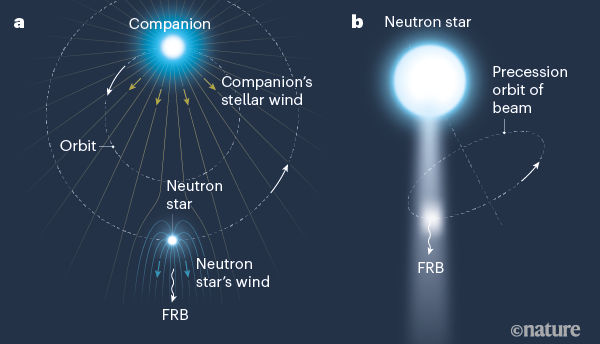
Two possible scenarios to explain the observed periodicity of an FRB. The source might be a neutron star in a binary system with a massive companion star. The FRB might be a glimpse of the neutron star’s stellar wind, in the lee of the wind of its companion, as it orbits through Earth’s field of view. Or FRBs might be emitted in focused ‘beams’ from in or near the magnetosphere of a highly magnetized neutron star. As these beams precess like a gyroscope, they would periodically enter Earth’s field of view.
Fast radio burst repeats every 16 days
Astronomers have seen dozens of mysterious ‘fast radio bursts’ (FRBs) — flashes of radio-frequency electromagnetic radiation — so far, some of them coming repeatedly from the same source. Now one source has been found to produce FRBs at regular intervals. The CHIME radio observatory in Canada saw FRB 180916.J0158+65 return 38 times between September 2018 and February 2020, with an intermittency of 16.35 days. It is still unclear what powers FRBs; some 51 theories have been proposed so far, and they could all be wrong, writes theoretical astrophysicist Bing Zhang. Perhaps periodicity is the key to understanding the mechanism underlying them, and if so, “it would mean that these natural phenomena are defeating the ability of the human imagination to explain it”.
Nature News & Views | 7 min readSource: Nature paper






















No hay comentarios:
Publicar un comentario